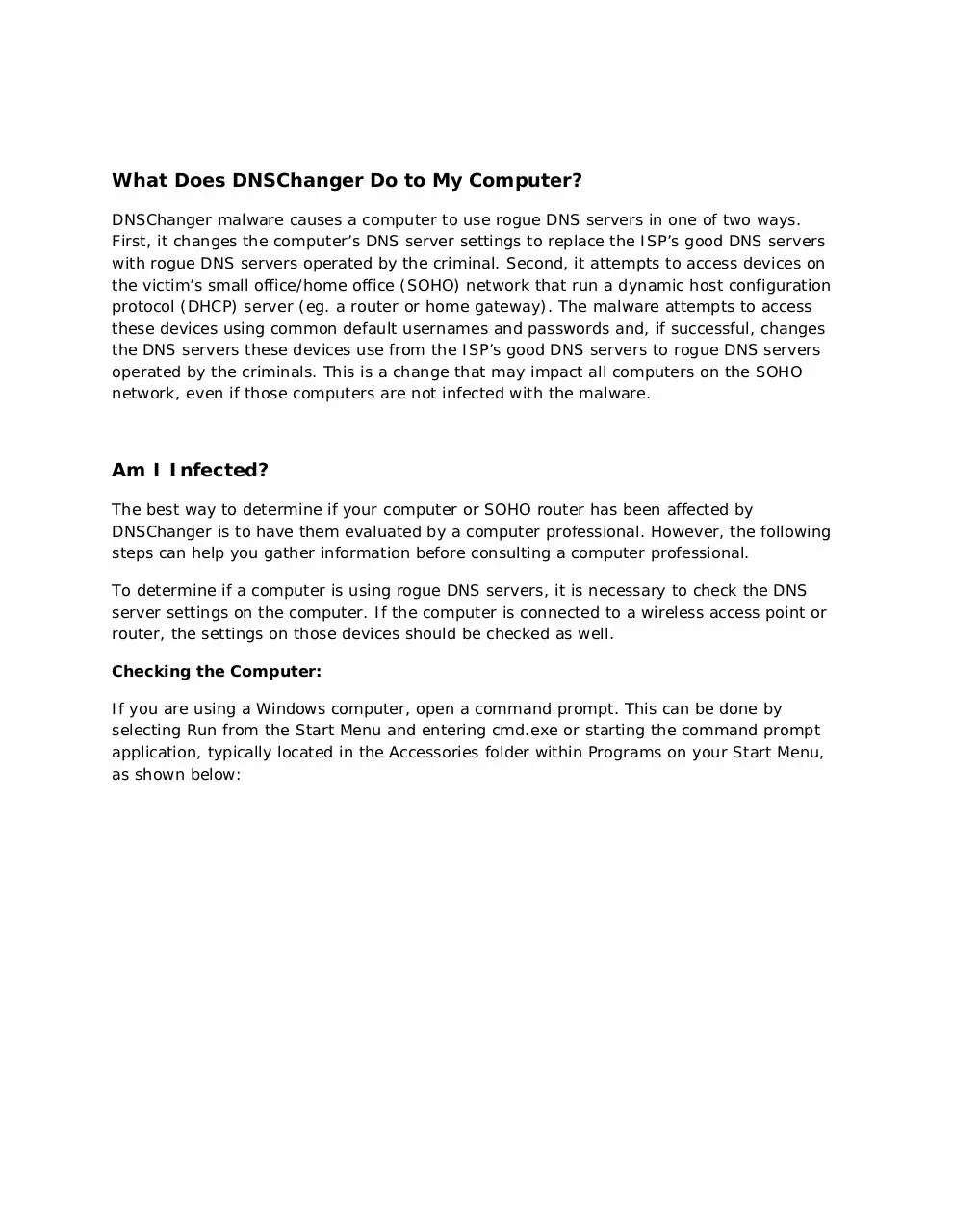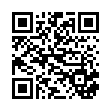dns changer malware (PDF)
File information
Author: Sam
This PDF 1.7 document has been generated by Microsoft® Word 2016, and has been sent on pdf-archive.com on 10/07/2017 at 14:03, from IP address 88.98.x.x.
The current document download page has been viewed 375 times.
File size: 468.45 KB (6 pages).
Privacy: public file





File preview
PPC Protect
DNSChanger Malware
DNS (Domain Name System) is an Internet service that converts user-friendly domain
names into the numerical Internet protocol (IP) addresses that computers use to talk to
each other. When you enter a domain name, such as www.fbi.gov, in your web browser
address bar, your computer contacts DNS servers to determine the IP address for the
website. Your computer then uses this IP address to locate and connect to the website. DNS
servers are operated by your Internet service provider (ISP) and are included in your
computer’s network configuration. DNS and DNS Servers are a critical component of your
computer’s operating environment—without them, you would not be able to access
websites, send e-mail, or use any other Internet services.
Criminals have learned that if they can control a user’s DNS servers, they can control what
sites the user connects to on the Internet. By controlling DNS, a criminal can get an
unsuspecting user to connect to a fraudulent website or to interfere with that user’s online
web browsing. One way criminals do this is by infecting computers with a class of malicious
software (malware) called DNSChanger. In this scenario, the criminal uses the malware to
change the user’s DNS server settings to replace the ISP’s good DNS servers with bad DNS
servers operated by the criminal. A bad DNS server operated by a criminal is referred to as
a rogue DNS server.
The FBI has uncovered a network of rogue DNS servers and has taken steps to disable it.
The FBI is also undertaking an effort to identify and notify victims who have been impacted
by the DNSChanger malware. One consequence of disabling the rogue DNS network is that
victims who rely on the rogue DNS network for DNS service could lose access to DNS
services. To address this, the FBI has worked with private sector technical experts to
develop a plan for a private-sector, non-government entity to operate and maintain clean
DNS servers for the infected victims. The FBI has also provided information to ISPs that can
be used to redirect their users from the rogue DNS servers to the ISPs’ own legitimate
servers. The FBI will support the operation of the clean DNS servers for four months,
allowing time for users, businesses, and other entities to identify and fix infected
computers. At no time will the FBI have access to any data concerning the Internet activity
of the victims.
It is quite possible that computers infected with this malware may also be infected with
other malware. The establishment of these clean DNS servers does not guarantee that the
computers are safe from other malware. The main intent is to ensure users do not lose DNS
services.
What Does DNSChanger Do to My Computer?
DNSChanger malware causes a computer to use rogue DNS servers in one of two ways.
First, it changes the computer’s DNS server settings to replace the ISP’s good DNS servers
with rogue DNS servers operated by the criminal. Second, it attempts to access devices on
the victim’s small office/home office (SOHO) network that run a dynamic host configuration
protocol (DHCP) server (eg. a router or home gateway). The malware attempts to access
these devices using common default usernames and passwords and, if successful, changes
the DNS servers these devices use from the ISP’s good DNS servers to rogue DNS servers
operated by the criminals. This is a change that may impact all computers on the SOHO
network, even if those computers are not infected with the malware.
Am I Infected?
The best way to determine if your computer or SOHO router has been affected by
DNSChanger is to have them evaluated by a computer professional. However, the following
steps can help you gather information before consulting a computer professional.
To determine if a computer is using rogue DNS servers, it is necessary to check the DNS
server settings on the computer. If the computer is connected to a wireless access point or
router, the settings on those devices should be checked as well.
Checking the Computer:
If you are using a Windows computer, open a command prompt. This can be done by
selecting Run from the Start Menu and entering cmd.exe or starting the command prompt
application, typically located in the Accessories folder within Programs on your Start Menu,
as shown below:
At the command prompt, enter:
ipconfig /all
Look for the entry that reads “DNS Servers……….”
The numbers on this line and the line(s) below it are the IP addresses for your DNS servers.
These numbers are in the format of nnn.nnn.nnn.nnn, where nnn is a number in the range
of 0 to 255. Make note of the IP addresses for the DNS servers and compare them to the
table of known rogue DNS servers listed later in this document. If the IP addresses of your
DNS server appear in the table below, then the computer is using rogue DNS.
You can also look for your DNS servers without using the command prompt.
For windows XP machines, click on Start and select My Network Places. Then select Network
Connections. In this example, the wireless connection is used.
Click on the connection that is active. This will bring up the Network Connection Status screen.
Click on Support and then Details. Check for the values that correspond to the DNS servers.
If you are using an Apple computer, click on the Apple in the top left corner and choose System
Preferences. Then, from the Apple System Preferences window, choose Network.
The Apple Network pane will show a number of possible connections on the left side. Choose
the one that is active for you and click on the Advanced button in the right lower corner.
Then choose DNS from the options to show the DNS servers you are using.
Compare whether your computer has DNS servers listed in the number ranges listed below.
Rogue DNS Servers
85.255.112.0 through 85.255.127.255
67.210.0.0 through 67.210.15.255
93.188.160.0 through 93.188.167.255
77.67.83.0 through 77.67.83.255
213.109.64.0 through 213.109.79.255
64.28.176.0 through 64.28.191.255
To make the comparison between the computer’s
DNS servers and this table easier, start by
comparing the first number before the first dot.
For example, if your DNS servers do not start
with 85, 67, 93, 77, 213, or 64, you can move on
to the next step. If your servers start with any of
those numbers, continue the comparison.
If your computer is configured to use one or more of the rogue DNS servers, it may be
infected with DNSChanger malware.
Home computers with high-speed Internet connections and office computers typically obtain
their IP settings via DHCP from a device on the network. In these cases, the computers are
provided with an IP address, default gateway, and DNS server settings. The IP addresses
usually fall into one of three ranges of private addresses—192.168.0.0 to 192.168.255.255;
172.16.0.0 to 172.31.255.255; and 10.0.0.0 to 10.255.255.255. In most homes, computers
are assigned an IP address in the range 192.168.1.2 to 192.168.1.254, and the default
gateway and DNS servers are set to 192.168.1.1. To determine if your computer is utilizing
the rogue DNS servers, read the next section, Checking the Router.
If you are unable to locate your DNS server settings, obtain assistance from the Help
program bundled with your operating system, reputable online sources, or a trusted
professional.
Checking the Router
Small office/home office routers connect your network of computers and devices to your
Internet service provider. The SOHO router may have been purchased and installed by you
or installed by your ISP. Linksys, D-Link, Netgear, and Cisco are common SOHO router
brands, but there are many others.
The DNSChanger malware is capable of changing the DNS server settings within SOHO
routers that have the default username and password provided by the manufacturer. If you
did not change the default password at the time the SOHO router was installed, you must
check the SOHO router settings.
The procedure to access your SOHO router setting varies by manufacturer, so consult your
product documentation. Once you have access to the SOHO router configuration, compare
the DNS servers listed to those in the rogue DNS servers table above. If your SOHO router
is configured to use one or more of the rogue DNS servers, a computer on your network
may be infected with DNSChanger malware.
What Should I Do?
In addition to directing your computer to utilize rogue DNS servers, the DNSChanger
malware may have prevented your computer from obtaining operating system and antimalware updates, both critical to protecting your computer from online threats. This
behavior increases the likelihood of your computer being infected by additional malware.
The criminals who conspired to infect computers with this malware utilized various methods
to spread the infections. At this time, there is no single patch or fix that can be downloaded
and installed to remove this malware. Individuals who believe their computer may be
infected should consult a computer professional.
Individuals who do not have a recent back-up of their important documents, photos, music,
and other files should complete a back-up before attempting to clean the malware or utilize
the restore procedures that may have been packaged with your computer.
Information regarding malicious software removal can be found at the website of the United
States Computer Emergency Readiness Team: https://www.uscert.gov/reading_room/trojan-recovery.pdf.
Download dns-changer-malware
dns-changer-malware.pdf (PDF, 468.45 KB)
Download PDF
Share this file on social networks
Link to this page
Permanent link
Use the permanent link to the download page to share your document on Facebook, Twitter, LinkedIn, or directly with a contact by e-Mail, Messenger, Whatsapp, Line..
Short link
Use the short link to share your document on Twitter or by text message (SMS)
HTML Code
Copy the following HTML code to share your document on a Website or Blog
QR Code to this page

This file has been shared publicly by a user of PDF Archive.
Document ID: 0000622562.